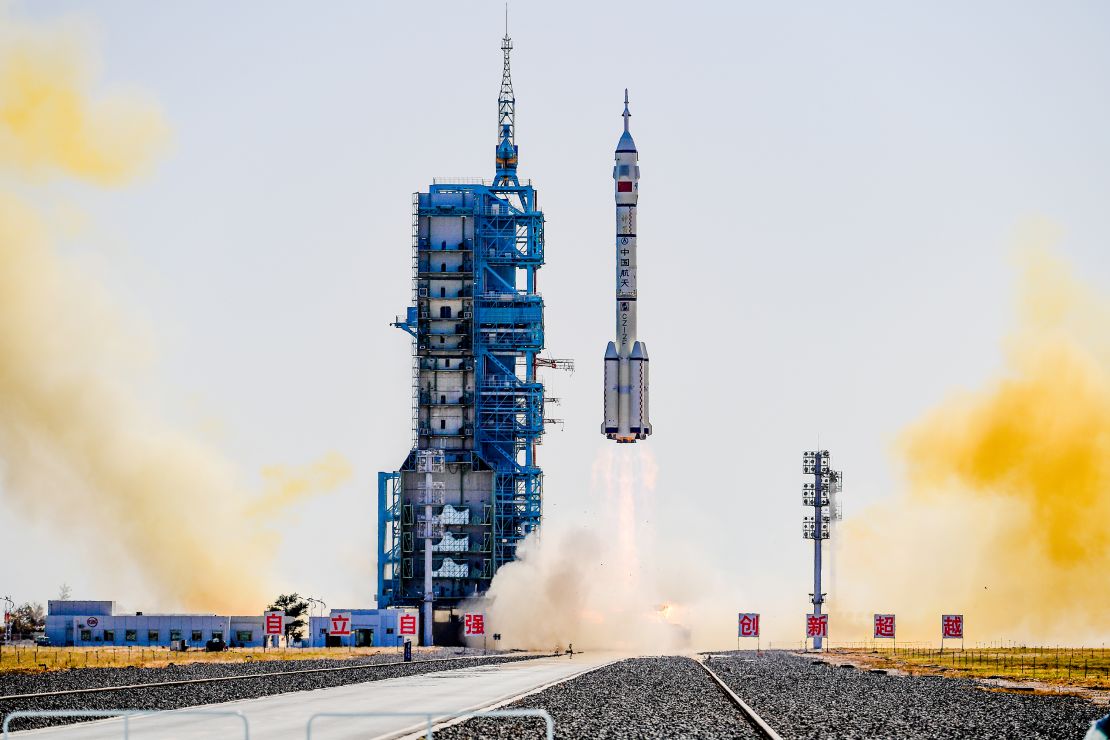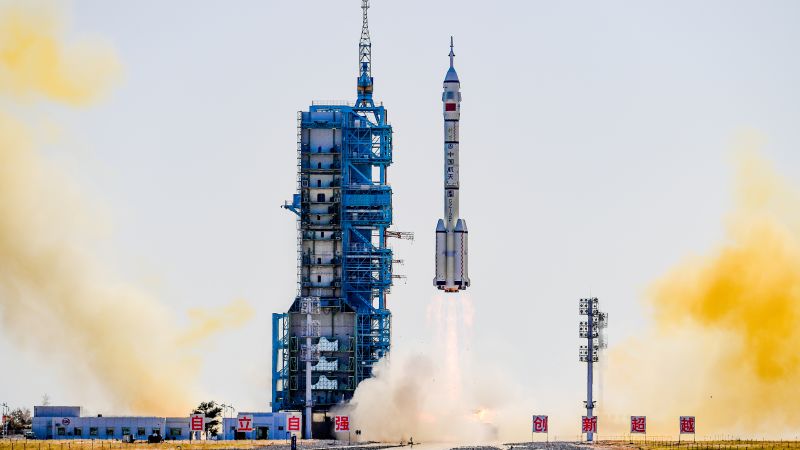Gobi Desert, China
CNN
—
When China’s first astronaut Yang Liwei blasted off into area in 2003, it was a historical past making second that declared his nation’s arrival as an rising area energy.
Twenty years on, China has develop into a significant presence in area – a standing that mirrors its rising financial, political and army ascendency on Earth. It now has its personal everlasting outpost in orbit – a completely operational area station – and routinely rotates crews to stay and work there.
On Thursday, three Chinese language astronauts lifted off on the Shenzhou-17 spacecraft from the Jiuquan Satellite tv for pc Launch Middle deep within the Gobi Desert, heading for the Tiangong area station for a six-month keep.
They’re the youngest crew China has ever despatched to area – with a mean age of 38. Amongst their duties on board is to restore the photo voltaic panels that had been broken by area particles – the primary time Chinese language astronauts will perform restore work exterior the station.
That is China’s sixth manned mission to its area station since 2021. The brand new crew will take over from the Shenzhou-16 astronauts, who’ve been onboard since Could.
Earlier than the launch, the crew was despatched off in full pageantry, greeted by authorities officers and supporters lining the highway. The three astronauts waved on the crowd, who held up Chinese language flags and flowers. A band performed patriotic songs and the gang sang alongside.
Since his personal journey to area, Yang has despatched off many Chinese language astronauts on their missions. However Thursday’s launch was particularly emotional, coming simply days after the twentieth anniversary of his personal historic flight.
“ this launch as a veteran, the very first thing I see is how far China’s manned spaceflight has come. Over the previous 20 years, it has developed quickly and made nice achievements,” Yang informed CNN on the Jiuquan middle on Wednesday, forward of the launch.
Accomplished late final yr, the Tiangong – or “heavenly palace” in Chinese language – is among the two area stations at present in orbit. With a lifespan of 15 years, it might develop into the one one left when the NASA-led Worldwide House Station (ISS) retires in 2030.
China has already introduced plans to broaden the Tiangong in coming years, including three modules to its current three to permit extra astronauts to remain overseas on the identical time. At present, it might probably home a most of three astronauts, in contrast with seven on the ISS.
Yang stated he was thrilled to see a youthful era of Chinese language “taikonauts” taking on the baton. “In them, I see the energy of our reserve power, and the hope for the long run growth of China’s aerospace trade,” he stated.
Two of the Shenzhou-17 crew members – Tang Shengjie, 33, and Jiang Xinlin, 35 – are new comers, having joined China’s third batch of astronauts solely just a little over three years in the past.
They’re led by Tang Hongbo, 48, who hails from the nation’s second batch of astronauts.
Tang, a former fighter jet pilot, was on China’s first crewed mission to its area station in 2021. His return to the Tiangong additionally set a brand new file for the shortest interval between two spaceflight missions by Chinese language astronauts.

Tiangong has develop into a logo of China’s ambition and capabilities in area, after Chinese language astronauts had been shut out of the ISS, a US-led collaboration with Russia, Europe, Japan and Canada, for greater than 20 years.
Since 2011, NASA has been successfully banned from cooperating with China, after Congress handed the Wolf Amendment as a consequence of espionage-related considerations. That exclusion has not less than partially spurred Beijing to construct its personal area station.
China has sought to open up its station to collaboration with worldwide companions, together with by internet hosting experiments from different international locations. And that supply might be all of the extra interesting after the ISS retires, which is scheduled round 2030.
Leroy Chiao, a former NASA astronaut and ISS commander, stated NASA has contracted with totally different non-public teams to create industrial area stations that its astronauts might function in. However “we’ll should see how all that goes,” he informed CNN.
“The opposite nations that take part in spaceflight, significantly human spaceflight, they’ve been speaking to China. And so in the event that they’re the one recreation on the town, that’s the one manner that these firms or these international locations can take part in human spaceflight, till we get these industrial area stations which might be partially funded by NASA into orbit and operational,” Chiao stated.
Beijing for years has been leveraging its rising prowess as a world area energy to supply partnerships and growth alternatives to different international locations.
As China and the USA intensify their financial, technological and geopolitical rivalry on Earth, area has develop into a pure extension – and essential frontier – of their nice energy competitors.
Following the demise of the Soviet Union’s area program, the US has loved a interval of unparalleled management in area. However in recent times, US observers and politicians have warned that America’s dominance might quickly be challenged by China’s fast-growing area capabilities.
That concern has solely deepened with a collection of essential and high-profile Chinese language achievements.
In 2019, China turned the primary nation to land on the far facet of the moon. A yr later, it efficiently put into orbit its remaining Beidou satellite tv for pc, setting the stage to problem the US World Positioning System (GPS). And in 2021, it turned the one nation after the US to place a functioning rover on Mars.
China’s ambitions don’t finish there. Subsequent yr, it plans to deliver again the primary samples ever collected from the moon’s far facet. By the top of this decade, it needs to ship astronauts to the moon and construct a global lunar analysis station. Various international locations have reportedly joined onto its deliberate lunar station, together with Russia, Venezuela and South Africa.
Chiao, the retired NASA astronaut, stated the primary problem now going through China’s area program is to get the operational expertise that a corporation like NASA has.
“We’ve been working spacecraft, area shuttle, area station for many years. And we now have a lot expertise and know-how on coaching astronauts on working in area – and that’s the place they’re taking part in catch up,” he stated.

